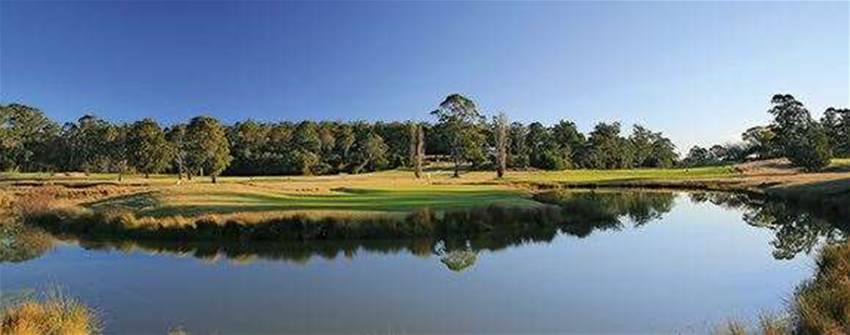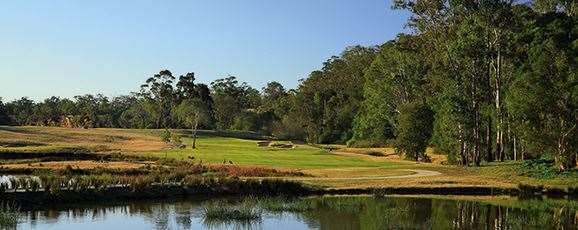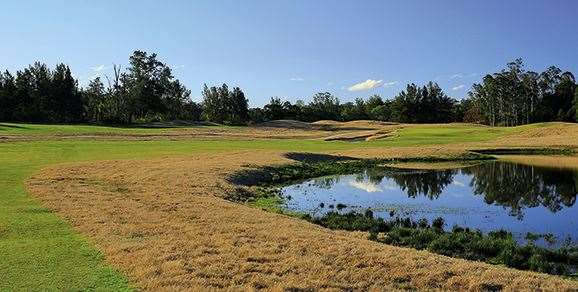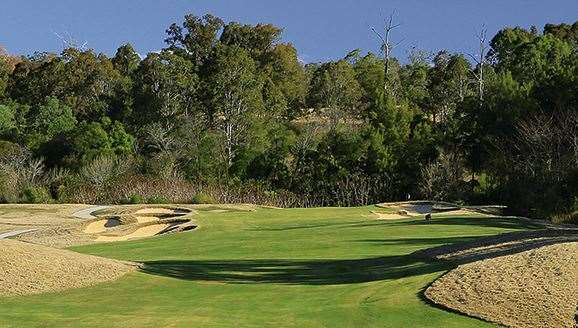A long-awaited and spectacular new addition to this popular resort complex opens this month, making Riverside Oaks the first 36-hole facility in Sydney.
A long-awaited and spectacular new addition to this popular resort complex opens this month, making Riverside Oaks the first 36-hole facility in Sydney.
Evidently good things really do come to those who wait.
Patience has been paramount for any golfer eagerly awaiting the long-mooted second golf course to materialise at Riverside Oaks on the north-western outskirts of Sydney. A discussion point for almost the entire lifetime of the now 28-year-old resort, the complementing Bungool layout will at long last reach fruition when it opens for play later this month.
I first toured the site of the potential course in early 2004 with former owner Pat Cunningham, who insisted then the second layout was imminent.
Depending on your outlook, ten years is or isn’t a long time in course construction, but with the finished product set to open you’d have to say the decade was worth the wait. Credit must go to current owners the Nanshan Group for following through on the plans and for choosing an architect with the nous of Bob Harrison to undertake the design work. Harrison brought to the project considerable experience working on numerous rural and semi-rural courses (The Vintage, Ellerston, Brookwater and Stonecutters Ridge, among others) and devised a layout that fits its bucolic riverside setting and diverges sufficiently from the Gangurru course without being a radical departure in style. The result is two courses that pair nicely as siblings; they share the same golf-course DNA while offering differing character and challenges.
Golfers familiar with Riverside Oaks’ original layout and the resort’s long, descending entrance road with the Gangurru course to the left might wonder where the Bungool course is located. Put simply, it sits to the right side of the entrance road and along the banks of the Hawkesbury River that was previously hidden from view. The overriding reaction of many will surely be: why wasn’t the first course built there?
It’s a legitimate question as the new site has so many natural advantages. The river holds both strategic and cosmetic value and couch grass common to the area assisted from an agronomy perspective. The course is divided in to two pockets by the tall rocky escarpment behind the clubhouse; one area (holes 1 to 7 plus 17 and 18) where the river is in view and the holes varying between low flats and gently undulating land, and the back section tucked along subtly rolling terrain with thicker stands of trees and more changes of direction to the fairways (holes 8 to 16). The physical separation is noteworthy as each half complements the other while also providing points of distinction.
The 6,305-metre Bungool course is almost identical in back-tee length to the Gangurru but places more of a premium on positioning the ball on what are deceptively wide fairways. Driving to one side of the fairway will be vital to opening up angles to several greens and hole locations within those greens. One slight oddity to the par-72 layout is the dearth of par-3s and par-5s – just three of each – but as Harrison says, “that’s what the land suggested”. In truth, you don’t notice this minor deviation from the four par-3, ten par-4, four par-5 composition that seems so prevalent in course architecture. Even with the three par-5s sandwiched into a six-hole stretch mid-round, the flow of strong par-4s captures the attention. The long and short holes are all fine tests but Bungool’s reputation stands to be built on the series of multi-dimensional two-shotters.
Some short, others long and some in between, the par-4s are a sublime mix of architectural assortment. One minute the test is an accurate lay-up then a finessed wedge, the next it’s a booming drive then a heroic long iron. There’s little question this will be the go-to course for visitors to Riverside Oaks in coming years.
The first seven holes and the last two opened briefly as a nine-hole excursion in 2013. This portion of the course is more established and takes in the best views of the river as it moves back and forth along a plain dotted with several water hazards. Many of Bungool’s best holes appear early. The 1st is a strong par-4 that in several ways indicates the examination to come: water is in play to the right from the tee (water that’s not visible from the elevated tee complex) before the fairway doglegs right and rises to a green set against a backdrop of several huge river gums with two bunkers guarding the front and left. Like many of the Bungool greens, the putting surface at the 1st contains a gentle scoop on the left edge that will feed balls off the green and into a chipping area below.
The 2nd might prove to be the toughest hole of all. A par-4 of 427 metres from the back tees, more water must be carried from the tee and these hazards also line the left side of the fairway in the driving zone. A shallow creek on the right and thick bushland further right offer little bailout option, meaning the second tee shot of the day needs to be a good one. The straight fairway progresses gently uphill to a moderate-sized green fronted by sand.
The 321-metre 3rd flanks the river and offers spectacular views of the watercourse as it bends against the rocky cliffs below. The river shouldn’t be in play on this short par-4 but a bad slice (or hook for lefties) might prove otherwise. In truth the hole is best played up the opposite side, as drives in the left half open a path to a diagonal green split in two by a large hump. More water is in play at the 4th, 5th and 6th holes, the first a downhill 353-metre par-4 with water wrapping around the front, left and back of the green and the next a 482-metre par-5 where a small pond intervenes on the second shot. How much the large lake in front of the par-3 6th green will be a factor depends on which tee you play from. The 195-metre rear tee requires a 180-metre carry to avoid the drink but the more sedate forward tees alleviate many of the headaches this scenic short hole brings on.
The 7th is similar to the 3rd hole – a short par-4 lined by the river and best played up the left side – yet the green complex is subtly different. Approach shots are best played to the left fringe of the green to allow the sloping terrain to feed the ball towards the flag. As with the 3rd, the 7th fairway features a lower right side that can obscure views of the flag. The 8th starts the stretch of newer holes, beginning with a par-5, par-4 and another par-5 that all follow the bend in the river without it being seriously in play (although the vegetation between these fairways and the river definitely is).
The series of par-4s from the 11th to 14th showcase Harrison’s artistry. Measuring 278, 400, 405 and 415 metres respectively, the invitation is to birdie the 11th and then hang on through the rest. The pick of this quartet might be the 13th, which has a generous fairway before the hole bends right towards a green set across a stream with bunkers behind. A good drive is required to open up the desired angle for the approach but many golfers will find themselves playing this hole as a three-shotter. The 14th is equally tough as it bends right around a lake that protects the ideal line from the tee.
The 15th is a cheeky par-3 of 148 metres where the positioning of the front bunkers can deceive the eyes when it comes to choosing a club, while the last true birdie chance comes at the 324-metre 16th, a par-4 along the back side of the rocky escarpment with a well-bunkered, two-tiered green. The uphill par-3 17th measures 153 metres from the back tees but can be played from a variety of distances. A high, left-to-right iron shot is called for to carry the bunker scheme at the front and to hold another green with multiple sections and run-offs at the sides.
A ball missing right will likely run all the way into the bush.
The layout partially trips at the final hurdle. Initially protected by a lone bunker on the higher right side of the fairway, the 371-metre par-4 18th now features two unusual sprawling traps on the left side that were constructed in an attempt to replicate the Nanshan logo but are, frankly, both an eyesore and an architectural mess. The even, parallel lips of these hillside bunkers are totally out of character with the terrain and the rest of the rugged, rustic bunkering. Harrison receives no blame, however, as these pots were a late addition made at the owner’s insistence.
We forgive this transgression and instead welcome a potent yet playable addition to the Sydney golf scene. Riverside Oaks has long given golfers a reason to escape suburbia; now those reasons have at long last doubled.
THE COURSE
LOCATION: O’Briens Rd, Cattai. Exit the M2 or M7 onto Old Windsor Rd. Turn right onto Pitt Town Rd and drive towards Wisemans Ferry for about 15 minutes. Riverside Oaks is on the left, about a 60- to 70-minute drive from the Sydney CBD.
CONTACT: (02) 4560 3200.
WEBSITE: www.riversideoaks.com.au
DESIGNER: Bob Harrison (2014).
PLAYING SURFACES: Couch (fairways, tees, rough); bentgrass (greens).
COURSE SUPERINTENDENT: Glenn Gibson.
PGA PROFESSIONAL: David Scott.
GREEN FEES: $105 (weekdays); $120 (weekends) including cart hire. Green fees on the adjoining Gangurru course are $70 on weekdays and $88 on weekends, including cart hire.
THE CLUB
MEMBERSHIPS: Riverside Oaks offers a $330 annual membership fee that includes a handicap and three rounds on the Gangurru course. The Platinum and Diamond categories include cart hire and range balls plus discounts throughout the resort. Men pay $2,100 for a Platinum membership, women and 18- to 27-year-olds $1,500, juniors $500 and families (two adults and two juniors) $3,600. This category provides seven-day access to the Gangurru course only. Diamond membership offers access to both courses for $2,988 for men, $2,370 for women and 18- to 27-year-olds, $870 for juniors and $5,358 for families. Both Platinum and Diamond categories also have five-day options.
CORPORATE GOLF: The resort is a popular venue for corporate golf, catering for fields anywhere between 16 and 250 players. The day can include golf clinics, meals, involvement by the Riverside Oaks professional staff, novelty events and more. The club’s operations staff can also handle all tasks from registration through to presentation.
ACCOMMODATION: Riverside Oaks recently bolstered its accommodation offering with 36 new resort rooms, including six executive suites.
PACKAGES: A special deal is available to coincide with the Bungool course’s opening: one night’s stay in a deluxe room with full breakfast and 36 holes of golf with a GPS-equipped cart (one round on each course) for $219 per person, twin share. This offer is available Mondays to Thursdays until February 23, 2015, excluding public holidays.
More play-and-stay packages remain available throughout the year. Contact Riverside Oaks for full details.
Related Articles

International Spotlight: Omanu Golf Club
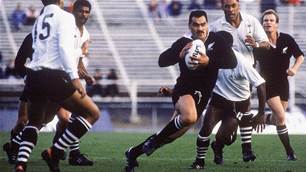
Celebrity Kiwi couple tee off in paradise

